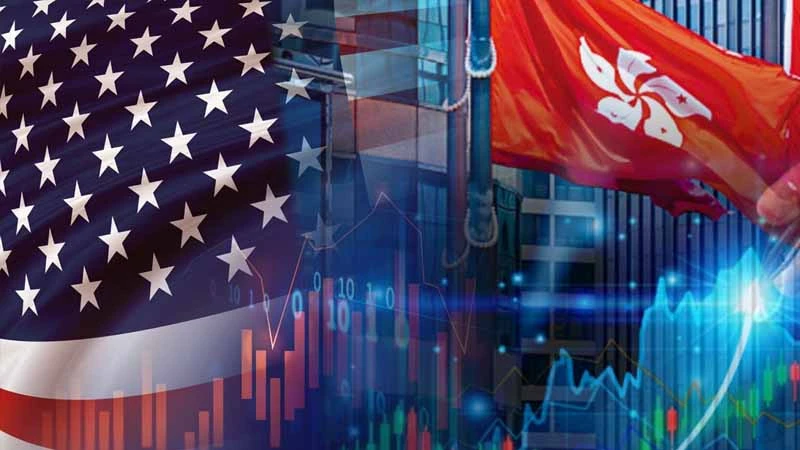Euro Asset Revaluation at a Structural Turning Point: Decoding a Decade-Strong Start of European Stocks and the New Normal of Exchange Rate Game
The STOXX 600 Index surged 14.2% at the start of the year, leading global markets, while the EUR/USD exchange rate remains stuck at the eight-year low of 1.07. Behind this “stock-currency divergence” lies the combined effect of corporate valuation recovery, the realization of geopolitical dividends, and monetary policy divergence. As the European Central Bank’s quantitative easing residue lingers and the US tariff list remains unresolved, euro-denominated assets are undergoing the most significant post-pandemic repricing logic shift.
The Best Start for European Stocks in a Decade: Low Valuations, Policy Dividends, and Global Capital Reallocation
In 2025, European stocks kicked off with impressive momentum, with Germany’s DAX Index rising more than 11% year-to-date and the STOXX 600 Index logging eight consecutive weeks of gains. This so-called “European miracle” rally stems not only from corporate earnings recovery and valuation through effects but is also closely related to geopolitical easing and spillover effects from US policy. This section breaks down the three main drivers of European stocks’ strength and explores its sustainability.
Corporate Earnings Cycle Turning Point and Sector Rotation
Industrial giant Siemens’ first-quarter earnings beat expectations, driving auto stocks up 4.4% in a single day, signaling that the recovery of European manufacturing has shifted from expectation to reality. Analysts note that European corporate net profit margins are rebounding at an annual pace of 1.5 percentage points, with valuations at a 30% discount compared to US stocks, creating a strong value-investing magnet effect. Notably, defense stocks have benefited from geopolitical risk premiums, rising 15% year-to-date, reflecting long-term bets on Europe’s defense autonomy.
Trump’s Policy as an Unexpected Gift
Although the “America First” policy has increased domestic market volatility, it has also pushed global funds to rebalance allocations. The STOXX 50 Index’s 15% annualized return outperformed the Nasdaq, indicating a shift from overvalued tech stocks to Europe’s stable assets. Morgan Stanley data shows hedge fund European stock positions rose from 17% to 19%, with significant additions in semiconductors and industrial equipment, a trend resonating with the potential export substitution effect brought by US reciprocal tariffs.
Liquidity Spillover and Central Bank Policy Divergence
The ECB’s quantitative easing has boosted eurozone inflation and output by 60 and 62 basis points respectively, while Fed rate-cut expectations have formed a “weak dollar-strong European stock” transmission chain. Notably, this European stock rally is accompanied by a 23% increase in average daily trading volume, showing strategic institutional positioning rather than short-term speculation. Whether the valuation recovery rally can sustain depends on whether companies can convert exchange rate advantages into order growth.
Euro Exchange Rate Volatility: Policy Divergence and Market Focus
The EUR/USD exchange rate’s repeated struggle at the 1.07 level reflects pricing contradictions over transatlantic policy divergence. Although ECB researchers have lowered inflation forecasts, suggesting rate cuts may come earlier than the Fed, geopolitical easing and a widening trade surplus still provide support. This section analyzes the euro’s trend from the perspectives of interest rate parity, capital flow, and technical patterns.
The Transmission Effect of Monetary Policy Divergence on Euro Exchange Rate Volatility
The ECB’s Asset Purchase Program (APP) once triggered a single-day euro depreciation of 2.33%. Current market pricing already reflects expectations of a 25-basis-point rate cut in June. If the Fed delays easing, the US-Germany two-year bond yield spread could widen to 150 basis points, pushing the exchange rate to break annual resistance levels. Notably, net euro short positions have fallen to their lowest level since 2023, indicating weakening short momentum.
Trade Balance and Capital Flow Tug-of-War
The eurozone’s trade surplus widened to 21 billion euros in January, but US reciprocal tariffs may cut auto exports by 6%. On the capital flow side, European REITs have attracted a 63% increase in US investment, while Asia-Pacific capital share has dropped to 9%, forming a “Western capital in, Eastern capital out” pattern. This structural shift has reduced the euro’s sensitivity to risk-off sentiment, instead making it positively correlated with risk assets.
Restructuring the Logic of Euro Asset Allocation under the New Geopolitical Normal
EU banks’ exposure to high-risk countries has reached 500 billion euros, accounting for 2.5% of total assets, indicating that geopolitical risks have shifted from tail threats to normalized factors. Investors need to rebalance between valuation advantages and political risks and establish a dynamic hedging framework.
Stable Asset Allocation Trends Driven by Policy
Utility stocks benefit from Europe’s energy independence policy, offering a dividend yield of 4.2% and volatility 15% lower than the broader market. Insurance companies are increasing holdings of euro-denominated corporate bonds, locking in a 3.8% yield while hedging against inflation risks. Alternative data shows that inflows into ESG-rated AA or above European stocks are 47% higher than traditional assets, reflecting the trend of responsible investing.
Potential Impact Assessment of Extreme Risk Events on the European Market
Based on historical experience, if geopolitical conflicts escalate again (such as the worsening Russia-Ukraine situation), European stocks could face a correction exceeding 10% in the short term. However, current valuations of most blue-chip stocks are approaching five-year lows, potentially providing a certain buffer for the market.
It is noteworthy that the European Central Bank, through bond purchase programs (such as OMT), has significantly reduced risk indicators for the spread of member states’ debt crises. From an investment strategy perspective, some institutions have adopted measures to reduce stock portfolio sensitivity to market volatility (such as lowering the proportion of cyclical industries) and slightly increased cash reserves to enhance flexibility.
Conclusion: Seeking Certainty Amid Divergence
The eurozone market is currently at a balance point of multiple forces, with monetary policy divergence, energy transition costs, and geopolitical restructuring continuously influencing capital flow directions. Although short-term economic growth slowdown and debt pressure constrain policy space, the EU’s substantial progress in green industry investment (such as hydrogen infrastructure) and supply chain diversification may inject medium- to long-term stability into the market. Going forward, close attention should be paid to the actual impact of energy price fluctuations and the efficiency of member states’ fiscal discipline implementation on market confidence.
Frequently Asked Questions
Q1: What is an opening?
An opening refers to the time when financial markets such as stocks, futures, and forex begin trading. Each exchange has a fixed daily opening time, marking the start of the trading session. The opening is usually automatically initiated by the exchange system, during which all eligible orders begin to be executed, and market participants can start buying and selling.
Key features of the opening:
Fixed time: Each market and exchange has a set opening time, usually at a specific time every day. For example, stock markets typically open at 9:00 AM or another designated time.
Price formation: At the opening, the market determines the opening price based on buy and sell orders. The opening price is the first transaction price of the day.
Market volatility: There can be significant volatility at the opening, especially in markets with fast information updates (such as stocks and futures). Investor sentiment and the previous day’s performance may influence short-term movements after the opening.
Start of trading: The opening marks the beginning of the day’s trading session, and investors can trade immediately after it opens.
For example, the opening time of A-shares is 9:30 AM, while the US stock market opens at 9:30 AM New York time (9:30 PM Beijing time). Before the opening, the market is closed, and trading cannot be conducted.
Q2: What time does Europe open?
The opening times of major European stock exchanges are as follows:
- London Stock Exchange (LSE)
Opening time: 8:00 AM (UK time, GMT) daily
Closing time: 4:30 PM (UK time, GMT)
During daylight saving time (March to October), it adjusts to 9:00 AM BST.
- Frankfurt Stock Exchange (Xetra)
Opening time: 9:00 AM (German time, CET) daily
Closing time: 5:30 PM (German time, CET)
During daylight saving time (March to October), it adjusts to 9:00 AM CEST.
- Paris Stock Exchange (Euronext Paris)
Opening time: 9:00 AM (French time, CET) daily
Closing time: 5:30 PM (French time, CET)
- Other European markets
SIX Swiss Exchange: Opens at 9:00 AM (Swiss time, CET), closes at 5:30 PM (Swiss time, CET).
Borsa Italiana: Opens at 9:00 AM (Italian time, CET), closes at 5:30 PM (Italian time, CET).
In summary, major European stock markets generally open at 9:00 AM CET (Central European Time), while some markets (such as London), have time differences.
Q3: Which is worth more, the euro or the US dollar?
Generally speaking, the value of the US dollar (USD) and the euro (EUR) fluctuates due to various factors, including economic data, policy adjustments, international trade, and geopolitical issues. According to the current exchange rate, the face value of the US dollar is usually lower, while the euro has a higher face value. However, this does not directly mean which currency is “more valuable”, as their purchasing power and market conditions differ.
- Exchange rate difference:
Based on exchange rates, 1 euro is usually worth more than 1 dollar. For instance, in recent years, 1 euro has been roughly equivalent to 1.1 to 1.2 US dollars, meaning 1 euro has higher purchasing power when converted into US dollars.
- Economic influence:
US dollar: The dollar is the world’s primary reserve currency, widely used in international trade and financial transactions. The US economy is one of the largest in the world, giving the dollar significant global influence.
Euro: The euro is the official currency of 19 eurozone countries and the second-largest reserve currency globally, playing an important role, especially in Europe and countries trading with the EU.
- Purchasing power and usage range:
USD: The US dollar has a wider global usage, not only in the United States but also in many countries and regions where it circulates as a trading and reserve currency.
EUR: The euro is mainly used in eurozone countries (such as Germany, France, and Spain), with relatively strong purchasing power, especially among consumers and businesses within the eurozone.
- Face value comparison:
Face value-wise, 1 euro can typically be exchanged for 1.1 to 1.2 US dollars. However, this does not mean its purchasing power is always stronger than the dollar, as living costs and commodity prices vary by country, affecting actual purchasing power.
Related articles
-
Since 2025, global financial markets have continued to focus on the monetary policy trends of the US Federal Reserve (Fed) and movements in the US Dollar Index. As a barometer of the international market, the performance of the US Dollar Index (DXY) directly affects asset prices and capital flows in...2025 年 3 月 18 日
-
2024 Q4 US Nasdaq Index plunged 3.6%, while the Hang Seng Tech Index fell 4.2% simultaneously, highlighting that the linkage between the two markets has deepened to the level of capital flows. Facing the Federal Reserve’s policy swings, the tech industry’s cyclical shifts, and rising geopolitical risks, Hong Kong stocks...2025 年 2 月 21 日
-
In February 2025, Donald Trump's 25% tariff on imported cars triggered an instant earthquake in the global supply chain. This trade policy, which has been labelled “America First 2.0", has not only forced multinational car companies to urgently reorganise production, it has also pushed the price of precious metals past...2025 年 2 月 21 日













